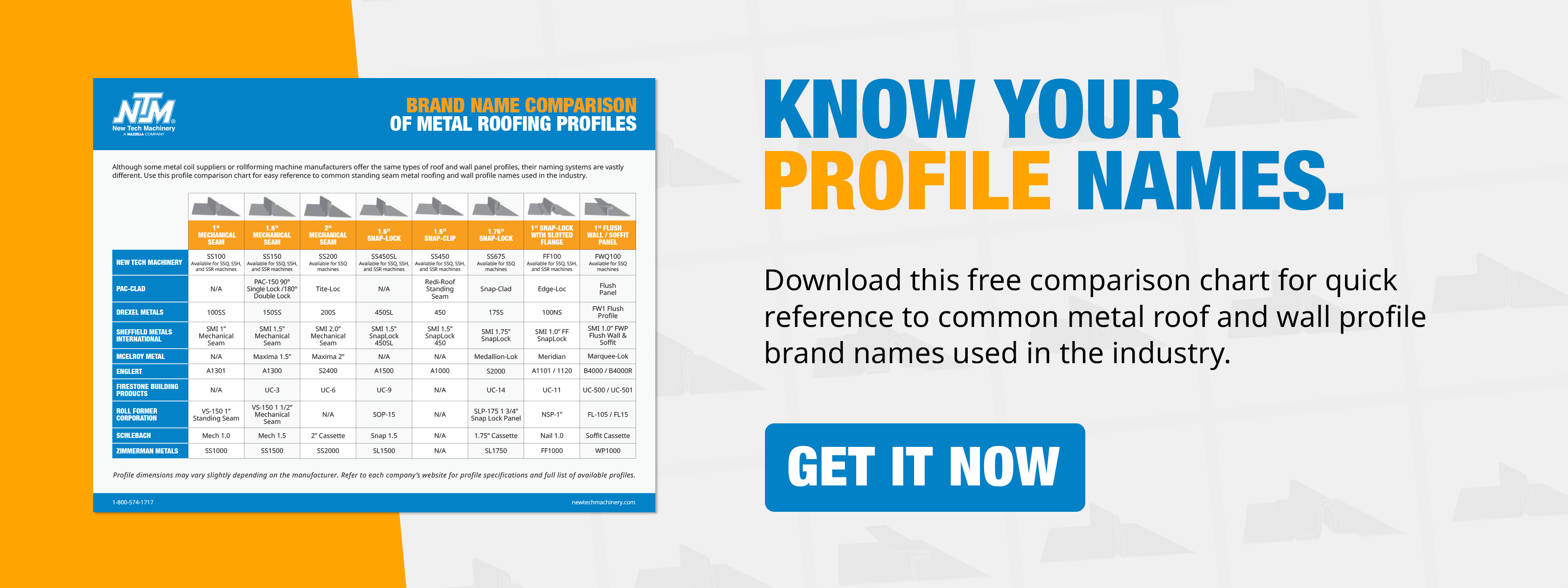Comparing Wall Siding Materials & How to Recommend the Best Siding Option

If you’re a roofing or siding contractor trying to help customers compare wall siding materials, understanding the pros and cons of the various kinds of materials used in wall siding and cladding can help.
There is a lot that goes into deciding what material is best suited for someone’s wall siding, so it’s important to know some of the popular kinds of materials that can be used, the pros and cons of each type of wall siding, and what to tell your customers to consider when deciding the right wall siding material to use.
Although New Tech Machinery is a portable rollforming machinery manufacturer, we know the importance of being an informed client and taking that education to your own customers to help them purchase the right type of material for their house or commercial building the first time around.
In this article we will cover:
- Pros and cons of various exterior wall cladding or siding materials
- What to consider when recommending wall siding or cladding material to a customer
Types of Exterior Wall Siding or Cladding Materials
Helping your customers understand which is the best cladding or siding materials to use for their residential or commercial building is important because there are various types available including metal, vinyl, brick, stone, and wood. The best way to determine which material type is best for your customer is to understand some of the pros and cons of each type of material.
Pros and Cons of Vinyl Siding

- Vinyl is one of the most popular materials used in siding for residential buildings.
- This material is typically available in a wide range of colors and styles.
- It’s long-lasting and can be designed to keep its color from fading
- Vinyl is rather lightweight and easy to install.
- Unlike metal or wood siding or cladding materials, vinyl doesn’t rot or scratch easily.
- Maintenance and cleaning vinyl siding is easy and only requires water or a mix of water and a mild cleaner.
However, using vinyl siding in some applications may have disadvantages:
- Vinyl can still fade or lose its coloring and may need to be replaced over time, although it will take many years.
- Although vinyl siding is easy to maintain, it does require routine cleaning to keep it free from mold, dust, and debris.
- Less thick vinyl can crack or become damaged from heavy impact or cold temperatures or melt when put up against high heat.
- The installation has to be done correctly or the siding can become damaged or susceptible to water intrusion.
Pros and Cons of Metal Wall Siding or Cladding

Using metal as a building wall siding or cladding has its advantages and disadvantages just like all the other materials discussed. There are different metal wall systems you can use including standing seam metal wall panels, one of the most popular and recognizable metal wall cladding systems.
Some of the advantages of using metal for wall siding or cladding are:
- There are many different types of metal materials you can use, each with its own advantages and disadvantages, including steel, aluminum, zinc, copper, etc.
- Metal, depending on the type you use, is incredibly durable and fire-resistant.
- Some metal wall panel systems, like IMPs and MCMs, can be made with insulation already built into the panel.
- They are recyclable, waterproof, and able to withstand high winds.
- Typically they require less maintenance and ongoing upkeep than other wall siding materials.
- Metal wall siding or cladding can also take the form of wood-style panels while offering the durability of metal (i.e. board-and-batten or woodgrain-embossed panels).
Cons of using metal as a wall siding or cladding option include:
- While metal is a durable material, it is more prone to denting or scratching.
- It does require expertise to install, especially with how different metal materials can react to expansion and contraction, hold up against hail, etc.
- Metal panels are susceptible to oil canning.
- Metal can fade or corrode when placed next to different metal types.

Pros and Cons of Brick Siding

Brick veneer or siding can provide a beautiful and long-lasting appearance to a building. Brick veneer is typically installed and adhered to a wooden frame.
Some advantages to using brick wall siding include:
- Brick is able to withstand harsh weather and fire better than some other materials.
- Brick veneer is lighter than using brick to make up the walls of a structure, and installation is quicker.
- Brick requires low maintenance and is environmentally friendly.
Disadvantages of using brick siding or veneer include:
- Brick is not a waterproof material and is able to absorb water easily, potentially leading to problems later on like mold or mildew.
- It is typically a more expensive material to install and repair if necessary.
- Brick is more limited in the kinds of colors available.
Pros and Cons of Stone Siding or Cladding

Stone is another option to use as wall siding that offers a natural look and feel to a building’s appearance. Stone as a veneer can come in natural or faux styles. Some of the advantages of using stone include:
- Stone is strong and fire-resistant, but it depends on the kind of stone you use.
- Depending on the type of stone used, they can come in various colors, patterns, and textures.
On the other hand, stone siding may not be the best option for various reasons:
- Real stone siding is costly and often hard to find the same color over time if you need it repaired or replaced.
- The installation process typically requires experience and is labor-intensive.
- Installing stone siding requires a moisture barrier and lathe to be placed between the stone and the structure of the building.
- Stone requires routine maintenance to keep it clean and avoid cracking.
Pros and Cons of Wood Siding or Cladding

Another popular siding material, especially on homes, wood siding comes in a variety of types like natural or composite wood, as well as the ways you can install it including board-and-batten, shingles, bevel, and split-log.
Some pros of using natural wood as a wall siding or cladding option include:
- Wood comes in many various color choices and grains and can be cut or shaped in different ways.
- As far as other siding material options go, natural wood is one of the easiest to install.
- Wood siding, when properly taken care of, can be a durable material and with the right sealers, resist fire and moisture damage.
Some disadvantages of using wood as a siding are:
- Natural wood materials are more expensive, especially now with the high cost of lumber prices.
- Wood siding requires more continuous maintenance (like staining or sealing the wood) to keep it protected from weathering or insects.
- If not treated with special products and kept treated, wood siding can burn easily.
Considerations to Make About Which Wall Siding or Cladding Material to Recommend

When choosing the right exterior wall siding or cladding material to recommend for a client’s residential or commercial building, you’ll want to be sure to help them understand the following factors and considerations.
Cost – When consulting with your customers, price is obviously one that comes up first. It’s important to relay the price of the materials, factors that can affect that cost, as well as how much they could be spending on future maintenance or repairs.
Durability and resistance to weather or elements – Between metal, brick, vinyl, stone, and wood, no two materials are able to handle weather and the elements the same way. Let your customers know which materials are capable of handling the harshest weather in their region, how durable the material will be for their residential or commercial building, and if there are any architect requirements for using any certain materials to best handle certain elements.
Maintenance required – Depending on the material your customer is looking to use for their exterior wall siding or cladding, the time and amount of maintenance needed to keep it in good condition will vary. Educating them on what to look for and when their siding or cladding may need maintenance can help get the most out of it.
Availability of materials – It’s not new to those in construction that certain materials are hard to come by right now. That being said, it’s critical that you make your customers aware of any lead times on supplies and how that affects the price and the timeline of the project.
Final Thoughts
As you now know, there are many options to recommend to your customers for a building’s exterior wall siding. Some will hold up better in harsh conditions, require less maintenance over time, or are more expensive.
All of the materials discussed have their benefits and disadvantages, so make sure your customers are aware of the material costs, installation requirements, how well the material can handle extreme weather and everyday use, and maintenance requirements.
At New Tech Machinery, we value knowledge and hope to provide our customers with the resources and knowledge they need to do their job right the first time and help educate their own customers.
If you have more questions about metal wall panels or metal construction or portable rollforming equipment, feel free to talk to any of our rollforming specialists or check out the Rollforming Learning Center for articles, videos, and downloadable resources.

